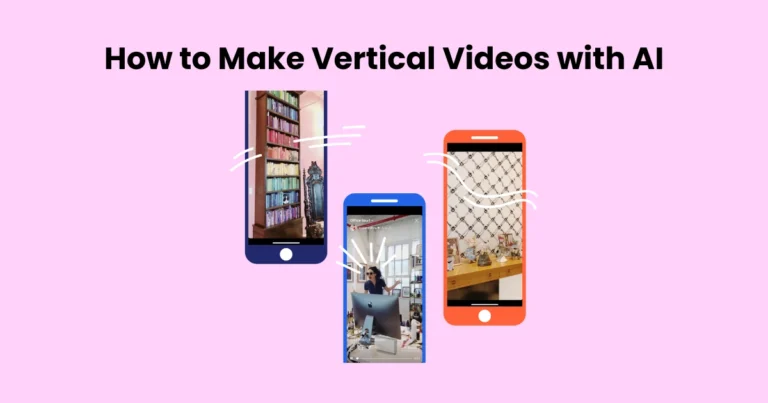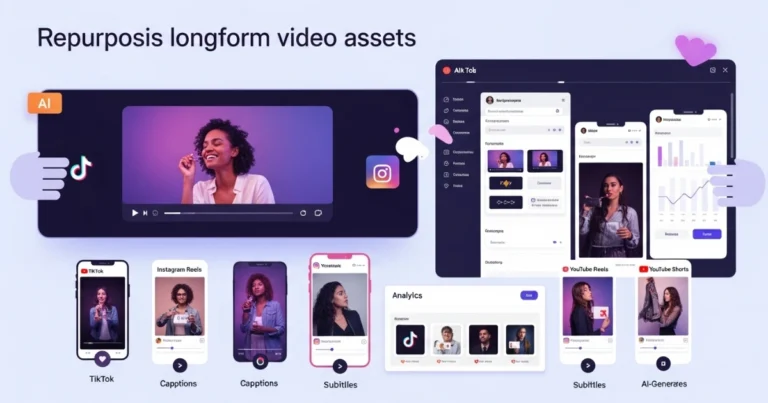Luma AI Video Generation

Contents
- 1 What is Luma AI Video Generation?
- 2 How Luma AI Works
- 3 Key Features of Luma AI
- 4 Benefits of Using Luma AI for Video Creation
- 5 Luma AI Video Generation Use Cases
- 6 Comparison With Other AI Video Tools
- 7 Steps to Generate a Video with Luma AI
- 8 Tips to Maximize Luma AI Video Quality
- 8.1 1. Start With High-Quality Input
- 8.2 2. Use Stable and Smooth Camera Movements
- 8.3 3. Optimize Lighting Conditions
- 8.4 4. Frame Your Subject Thoughtfully
- 8.5 5. Experiment With Camera Paths
- 8.6 6. Preview Before Rendering
- 8.7 7. Render in the Highest Quality Available
- 8.8 8. Edit Final Output With Post-Processing Tools
- 9 Common Challenges and How to Overcome Them
- 10 Future of Luma AI Video Generation
In the fast-paced world of digital content creation, Luma AI video generation stands out as a revolutionary tool that is transforming how we produce videos. With the power of artificial intelligence, Luma enables users to generate ultra-realistic, cinematic visuals from text prompts, images, or 3D scans making it a top choice for creators and brands aiming to save time and reduce production costs.
Unlike traditional video production methods, which often require expensive equipment and complex editing skills, Luma AI video generation simplifies the process dramatically. You no longer need to be an expert videographer; with just a few clicks, you can produce lifelike animations and immersive visuals. This groundbreaking technology is not only accessible but also scalable, offering creative freedom to artists, marketers, and developers alike.
As we explore this powerful tool, you’ll learn how Luma AI video generation works, what makes it unique, and why it’s quickly becoming the go-to solution for next-gen video content. From user-friendly features to real-world applications, this article covers everything you need to know.
What is Luma AI Video Generation?
Luma AI video generation is a cutting-edge technology that uses artificial intelligence to create highly realistic videos from simple inputs like text descriptions, images, or 3D scans. Powered by neural rendering and advanced machine learning models, Luma’s platform translates static data into dynamic, visually immersive video content without the need for traditional video production tools.
At its core, Luma AI harnesses the power of NeRF (Neural Radiance Fields) technology, enabling it to reconstruct photorealistic scenes from multiple angles. This makes it ideal for tasks such as product visualization, cinematic content creation, real estate previews, and even virtual reality environments.
Furthermore, Luma AI video generation eliminates many of the technical barriers that creators face. Instead of relying on complex editing software or high-end computers, users can simply input their assets and let the AI do the heavy lifting. The result? Smooth, professionally rendered videos that look as though they were captured with high-end cameras.
Because it automates much of the creative process, Luma AI video generation significantly reduces production time. At the same time, it maintains full creative control, giving users the ability to fine-tune their outputs based on lighting, perspective, texture, and more.
Ultimately, Luma AI isn’t just another video tool it’s a revolutionary approach to content creation that blends realism with simplicity. As more industries adopt this technology, its impact on the future of video production continues to grow.
How Luma AI Works
Luma AI video generation works by combining advanced AI models, neural rendering techniques, and intuitive user input methods to create photorealistic video content. It starts with the user providing basic input this can be a set of images, a 3D scan, or even a text prompt. From there, Luma’s AI begins interpreting the data, reconstructing it in a three-dimensional space.
At the heart of this process lies NeRF (Neural Radiance Fields) technology. NeRF allows Luma to capture fine details, lighting, shadows, and depth, producing results that mimic real-world scenes. Unlike traditional rendering, which requires high-end GPUs and manual setup, Luma AI video generation automates everything, delivering cinematic-quality videos with minimal user effort.
Once the 3D scene is generated, the platform lets users select angles, apply camera movements, and adjust lighting. The AI dynamically refines these elements, ensuring the final video looks smooth and realistic. Moreover, it supports rendering in high resolution, which makes it suitable for professional use in marketing, gaming, and virtual tours.
Another advantage is that Luma AI video generation operates in the cloud. Users don’t need powerful hardware to produce complex animations all the heavy processing happens on Luma’s servers. This scalability makes it accessible to both individual creators and large teams.
In short, Luma AI works by intelligently turning static visuals into engaging video content. It democratizes high-end video creation, allowing users to focus on creativity while the AI handles the complexity.
Key Features of Luma AI
Luma AI video generation offers a rich suite of features designed to streamline the video creation process while delivering high-quality results. These features cater to both beginners and professionals who seek efficiency, realism, and control.

1. Photorealistic Rendering
Luma AI delivers incredibly lifelike results using Neural Radiance Fields (NeRF). This allows the AI to simulate natural lighting, textures, and shadows, producing videos that look as if they were shot with a professional camera.
2. 3D Scene Reconstruction
One of the core capabilities of Luma AI video generation is its ability to rebuild complete 3D environments from simple scans or images. It uses deep learning to understand spatial relationships and then fills in the gaps with realistic visual data.
3. Easy-to-Use Interface
Luma provides a user-friendly dashboard that lets creators upload assets, preview scenes, and render outputs with just a few clicks. No advanced technical knowledge is required.
4. Cloud-Based Processing
Instead of relying on your computer’s hardware, Luma AI video generation performs all rendering in the cloud. This not only speeds up processing but also makes the tool accessible from anywhere.
5. Cinematic Camera Controls
Users can direct their videos by selecting camera angles, movement paths, and focal points. These cinematic controls bring creative storytelling to life without the need for traditional filming.
6. High-Resolution Output
Whether you’re creating content for social media, advertising, or virtual reality, Luma allows you to export videos in high definition or 4K, depending on your project needs.
7. Real-Time Previews
To make the creative process more efficient, Luma AI video generation provides real-time previews. Users can see how their changes will affect the final output before rendering the full video.
In summary, Luma AI is packed with powerful features that make professional video creation accessible, fast, and visually stunning.
Benefits of Using Luma AI for Video Creation
Using Luma AI video generation offers a wide range of benefits that appeal to creators, marketers, developers, and educators. Its ease of use, combined with advanced AI capabilities, makes it one of the most powerful tools for video production today.

1. Time Efficiency
Traditional video production can take days or even weeks. With Luma AI video generation, you can produce high-quality visuals in minutes. The automated rendering process handles the heavy lifting, allowing you to focus on creativity instead of logistics.
2. Cost Reduction
Hiring video crews, renting equipment, and editing footage can be costly. Luma AI eliminates these expenses by offering a full-service platform that generates professional videos without external resources.
3. Creative Freedom
Whether you’re working on marketing campaigns, product demos, or virtual environments, Luma AI video generation gives you the flexibility to control every visual element. From camera angles to lighting and movement, you maintain full creative direction.
4. Accessibility for All Skill Levels
Even if you have no background in video editing or 3D modeling, Luma AI empowers you to produce polished content. Its intuitive interface and guided workflows make it ideal for beginners and professionals alike.
5. High-Quality Output
The platform delivers stunning photorealistic videos using cutting-edge AI. These visuals are suitable for high-end projects, from corporate presentations to immersive digital experiences.
6. Scalability for Teams and Businesses
Luma AI is built for scale. Whether you’re a solo content creator or part of a large media team, you can collaborate, store, and render projects in the cloud with ease.
7. Real-Time Feedback and Adjustments
Because Luma AI video generation supports real-time previews, you can make changes quickly without waiting for full renders. This reduces trial-and-error and speeds up project turnaround.
In essence, Luma AI bridges the gap between imagination and production, allowing anyone to create captivating video content without compromise.
Luma AI Video Generation Use Cases
Thanks to its versatility and ease of use, Luma AI video generation is being adopted across various industries. From content creators to corporate teams, the use cases are broad and continually expanding.

1. Marketing and Advertising
Marketers can leverage Luma AI video generation to produce eye-catching promotional videos without expensive production crews. Whether you’re advertising a product launch or running a social media campaign, Luma helps you create engaging visuals quickly and affordably.
2. E-Commerce and Product Visualization
Online retailers can use Luma to create 360° product views and immersive product showcases. With its realistic rendering capabilities, Luma AI video generation brings items to life enhancing customer engagement and boosting conversions.
3. Real Estate and Architecture
Architects and real estate agents use Luma AI to generate virtual property tours and walkthroughs. Instead of relying on static images or mockups, clients can explore lifelike environments rendered directly from floor plans or scans.
4. Film and Animation
Independent filmmakers and animation studios benefit from Luma AI video generation by reducing production time and cost. It allows them to generate detailed scenes, experiment with camera angles, and animate environments without needing physical sets.
5. Education and Training
Instructors and trainers use Luma-generated videos to explain complex topics through immersive visuals. Whether it’s virtual science labs or historical reconstructions, Luma brings learning materials to life.
6. Gaming and Virtual Worlds
Game developers utilize Luma AI video generation to build cinematic cutscenes, game trailers, and 3D environments. The platform helps speed up content creation for both indie and AAA titles.
7. Social Media and Influencers
Content creators on platforms like YouTube, Instagram, and TikTok use Luma AI to produce high-quality videos that stand out. It empowers influencers to create unique, professional-looking content without hiring editors.
In short, Luma AI video generation offers practical solutions for a wide range of industries, redefining how digital visuals are created and consumed.
Comparison With Other AI Video Tools
When it comes to AI-powered video creation, the market includes many popular platforms such as Runway, Pika Labs, Synthesia, and Kaiber. However, Luma AI video generation distinguishes itself through its focus on photorealism, user control, and real-time 3D reconstruction. Let’s explore how it stacks up against the competition.

1. Luma AI vs. Runway
Runway specializes in text-to-video and green-screen editing, offering tools tailored to video editors and VFX artists. While powerful, Runway focuses more on stylized effects. In contrast, Luma AI video generation excels in creating natural, photorealistic videos using 3D scans and NeRF-based rendering, making it ideal for immersive content.
2. Luma AI vs. Synthesia
Synthesia is built primarily for corporate videos and avatars. It offers excellent support for voiceover and script-based AI presenters. However, it lacks the visual realism and 3D flexibility that Luma AI video generation provides. Luma is better suited for scenes requiring depth, environmental realism, and dynamic camera movement.
3. Luma AI vs. Kaiber
Kaiber offers animated visual styles and AI transformations that are often abstract and art-focused. While creative, it doesn’t match the physical accuracy of Luma AI video generation, which recreates real-world lighting, spatial structure, and natural motion with precision.
4. Luma AI vs. Pika Labs
Pika Labs is gaining traction for its generative video capabilities from text prompts, similar to Runway. However, it currently lacks detailed 3D scene building and real-world reconstruction. This is where Luma AI video generation shines, offering users not just videos, but immersive spatial storytelling.
Final Verdict
Most AI video tools cater to one niche be it avatar creation, stylized visuals, or green-screen editing. Luma AI video generation, on the other hand, bridges multiple disciplines by enabling photorealistic 3D video creation, flexible camera control, and real-time rendering in a cloud-based environment.
Steps to Generate a Video with Luma AI
Creating high-quality videos with Luma AI video generation is both quick and intuitive. Whether you’re a beginner or an experienced creator, the platform guides you through a simple workflow to transform your ideas into cinematic visuals.

Here’s a step-by-step guide to help you get started:
1. Sign Up or Log In
Begin by visiting Luma’s official website. Create a free account or log in if you already have one. Once you’re in, you’ll have access to the dashboard and available tools for video creation.
2. Capture or Upload Source Material
Next, you can either:
- Upload a short video or a set of images, or
- Use your smartphone to scan a 3D environment using Luma’s mobile app (if available).
This is a critical input stage that allows Luma AI video generation to build a realistic 3D scene.
3. Select the Scene Type
After uploading, choose the type of scene you want to create. Options include product visualization, interior walkthroughs, outdoor environments, or cinematic sequences.
4. Customize Camera Paths and Angles
Using Luma’s interface, set the camera movements. You can define entry and exit points, angles, and even tracking shots. This gives you full creative control over how the viewer experiences the video.
5. Adjust Lighting and Scene Effects
Enhance your scene by adjusting lighting conditions like time of day, shadows, or ambient effects. Luma AI video generation allows for photorealistic adjustments to create a cinematic feel.
6. Preview Your Video
Before rendering, preview your video in real time. This helps you make quick adjustments and ensures everything looks right before committing to the final output.
7. Render and Export
Once satisfied, hit “Render.” Luma will process the video in the cloud. After rendering is complete, you can export it in various resolutions, including HD and 4K, depending on your settings.
Finally, download your finished video. You can now share it across social media, use it in presentations, or integrate it into your marketing campaigns.
Luma AI video generation transforms complex video creation into a smooth, guided experience. In just a few steps, you can produce professional videos that rival those created with large budgets and teams.
Tips to Maximize Luma AI Video Quality
To get the best possible results from Luma AI video generation, you should follow certain best practices. These tips will help you enhance the final output, ensuring your videos look polished, cinematic, and professional.

1. Start With High-Quality Input
The quality of your source material whether it’s a video clip, a set of images, or a 3D scan directly affects the final result. Use high-resolution footage with good lighting to give Luma AI video generation the best data to work from.
2. Use Stable and Smooth Camera Movements
When capturing video for scene reconstruction, avoid shaky or jerky camera motions. Smooth, steady pans or walkarounds improve tracking and result in cleaner 3D environments.
3. Optimize Lighting Conditions
Well-lit scenes are easier for Luma AI to process accurately. Shoot during daylight or use artificial lighting to reduce noise and ensure all object details are visible.
4. Frame Your Subject Thoughtfully
Composition matters. Make sure the subject of your scene is well-centered and unobstructed. Clear subject placement enhances the storytelling aspect of Luma AI video generation.
5. Experiment With Camera Paths
Luma allows you to create custom camera movements. Try cinematic angles like slow zoom-ins, flyovers, or rotating shots to make your video visually dynamic.
6. Preview Before Rendering
Always use the preview feature before finalizing your video. This lets you check for alignment issues, lighting flaws, or undesired movements saving time on re-renders.
7. Render in the Highest Quality Available
If your system and time allow, always choose the highest resolution output available. Luma AI video generation supports HD and 4K rendering, making your videos ideal for commercial use or large screens.
8. Edit Final Output With Post-Processing Tools
Once your Luma video is ready, you can enhance it further using software like Adobe Premiere Pro or DaVinci Resolve. Add music, text overlays, or transitions to make your content stand out even more.
Common Challenges and How to Overcome Them
While Luma AI video generation revolutionizes video creation, users may still encounter some common challenges. Understanding these hurdles and knowing how to address them can significantly improve your workflow and results.
1. Low-Quality Source Material
One frequent issue is using low-resolution or poorly lit input images and videos. This reduces the accuracy of the 3D reconstruction and leads to grainy or blurry final videos.
How to overcome: Always start with high-quality footage. Use good lighting and steady camera movements when capturing scenes.
2. Long Render Times
Rendering complex videos with photorealistic detail can take time, especially at higher resolutions. This might slow down your production process.
How to overcome: Plan your projects by allowing ample time for rendering. Use preview mode to finalize scenes before committing to long renders.
3. Hardware Limitations
Although Luma AI relies heavily on cloud processing, local hardware can still affect how smoothly you interact with the software. Lower-end devices may struggle with previews or editing.
How to overcome: Use a device with sufficient RAM and a modern GPU for the best experience. Consider upgrading hardware if you work extensively with large projects.
4. Complex Scene Setups
Intricate environments with many moving parts or reflective surfaces can confuse the AI, causing visual artifacts or errors.
How to overcome: Simplify scenes when possible. Avoid cluttered backgrounds and use neutral surfaces to help Luma AI better interpret the scene.
5. Learning Curve
For beginners, mastering all the features of Luma AI video generation may take time. This can lead to initial frustration.
How to overcome: Take advantage of tutorials, community forums, and official documentation. Practice regularly to build confidence and skills.
6. Limited Customization Options
Some users might find that certain niche effects or highly specific animations are not yet supported.
How to overcome: Combine Luma AI outputs with traditional video editing or animation tools for added effects and refinement.
By proactively addressing these challenes, you can maximize the potential of Luma AI video generation and create stunning videos more efficiently.
Future of Luma AI Video Generation
The future of Luma AI video generation looks incredibly promising, as advancements in AI, machine learning, and 3D rendering continue to accelerate. Here’s what to expect in the coming years.

1. Improved Real-Time Rendering
As computing power grows and algorithms become more efficient, Luma AI will likely offer near-instantaneous rendering. This will allow creators to see their video projects evolve live, speeding up workflows dramatically.
2. Enhanced User Customization
Future versions of Luma AI are expected to provide even deeper control over scene elements, including advanced lighting effects, textures, and animations. This will empower users to create highly personalized and complex videos with ease.
3. Integration With Other Creative Tools
Luma AI will likely integrate more seamlessly with popular editing suites and design software, enabling smoother workflows and more robust post-production capabilities. This integration will broaden its appeal to both amateur and professional creators.
4. Expansion of Use Cases
As AI video generation technology matures, expect Luma AI video generation to expand into new industries such as virtual reality (VR), augmented reality (AR), and interactive gaming. This growth will open up exciting possibilities for immersive storytelling.
5. Lower Barriers to Entry
With improved interfaces and automated features, Luma AI will become even more accessible to beginners. This democratization of video creation will empower a wider audience to produce high-quality, cinematic content without extensive technical knowledge.
Conclusion
In summary, Luma AI video generation is revolutionizing the way creators produce high-quality, photorealistic videos with ease and precision. Its powerful features, combined with intuitive controls and cloud-based rendering, make it an ideal tool for filmmakers, marketers, and digital artists alike.
By understanding how Luma AI works, exploring its key benefits, and following best practices, you can maximize your video quality and efficiency. Despite some common challenges, the technology continues to improve rapidly, opening up exciting new possibilities for creative storytelling. As the future unfolds, Luma AI video generation promises to become even more accessible and versatile, empowering users of all skill levels to craft stunning, immersive videos. Whether you are a beginner or a professional, now is the perfect time to explore what Luma AI can do for your projects.






